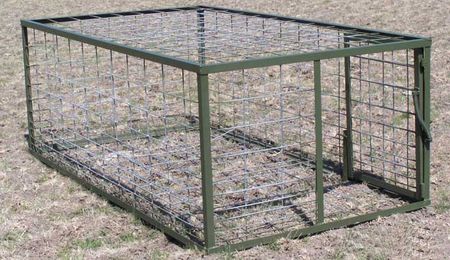Trapping hogs can be an effective method for controlling local hog populations. However, before setting live hog traps, make sure you scout the area and try to locate fresh hog signs. Pre-baiting of an area at least a week in advance will help in getting the hogs to return to the area in which the trap is to be set. In fact, I consider this a must for successful hog trapping. The more time you put into creating a successful hog trapping site before the trap is set, the better off you will be and the more hogs you will catch!
To first attract wild hogs to the trap site, set the trap on flat ground and wire the door open so that hogs can come and go as they wish. Bait the inside of the trap, leaving a small trail of bait through the door to the outside of the trap to lure hogs inside. It also helps to leave bait outside the trap to get the hog comfortable with feeding in and around the trap. Good baits for hog trapping include sweet vegetables and soured grains such as corn, rice, or milo. To create soured grain, simply fill a 5 gallon bucket about 1/2 full with your grain of choice, then fill the bucket with water, place it in the sun, and wait a few days.

Leave the trap door wired open for several days so the hogs will get used to entering the trap for the bait. After it is apparent that hogs have been entering the trap, set the door open by placing a stick between the door and trap side or ground if a root door. Tie a piece of rope to the prop, stringing the rope loosely through the top of the cage, and let the remainder of the rope hang down into the cage. At this end of the rope, a bucket of soured corn or other type bait can be tied to complete the trap set. It is simple, but an effective way to set your hog trap.
As feral hogs enters the trap and start feeding out of the bucket, the attached rope will pull the prop from between the spring door and the door jamb causing the trap door to close, if a big hog has not already knocked the prop loose. Additionally, a trapped hog may entice additional hogs, especially smaller hogs if a sow is initially captured, to enter by pushing through the closed spring or root door. There are many ways to live trap feral hogs so you can an experiment with what works for you. Hog trap design is important, as well, but hopefully this wil get you on your way to controlling the feral hog population in your area.
Feral hogs are much smarter than most people give them credit. Trapping hogs takes patience since the older animals are very leary of traps. I’ve had the best luck with corral type traps, but box traps can be effective for solitary boars.